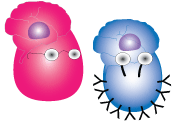
T cell activation
Mature, naïve CD4+ and CD8+ T cells leave the thymus and circulate around the body in a resting state. When they pop out in a secondary lymphoid organ by squeezing through the HEVs, as we saw in the lymphocyte life cycle page, they gather together with other T cells to form a T cell zone. Here they meet antigen presenting cells, usually DCs, and using the TCR as antennae, they test many peptide:MHC complexes. By trial and error they find a complex to bind which triggers an activation signal, the first in a series of signals, in the T cell. The TCR is part of a sensory system which relays messages from the surface of the cell to the nucleus. This alerts the T cell to the presence of a foreign peptide and tells it that it is time to wake up and mount an immune response. The next video gives a very detailed illustration of the events taking place during T cell activation. You will see how the TCR complex is made up of a TCR molecule, which provides the antigen specificity, and another set of molecules collectively named the CD3 complex. While watching this video can you figure out why the CD3 complex is needed?

Did you notice how the TCR extends only a short tail into the cell cytoplasm and is incapable of sending messages as it lacks signalling motifs? The signalling capacity of the TCR complex comes from associating with CD3 molecules containing these necessary motifs. But there were other molecules also present in the video during T cell activation like CD45 and the co-receptor CD4 which contributed to the signalling. In actual fact, there are many other molecules involved T cell activation. We have already talked about the importance of costimulatory and adhesion molecules for antigen presentation in the linker module. By watching the same video again, remind yourself which molecules these are and this time, why they are important for T cell activation?
Costimulatory molecules send the secondary signals which confirm to the T cell that there is a foreign antigen present and they are needed to get full activation, especially of naive T cells. When T cells are fully activated, they divide and become either effector or memory cells. Effector cells are those cells that actively carry out specific functions. Effector CD4+ helper T cells secrete bucket loads of cytokines important, for example, for helping B cells to produce antibodies (which we will learn more about in the B cell pages), whereas effector CD8+ T cells are assassins ready to kill other cells which you can see in this video.
But what happens to T cells when the antigen signal is not followed by the costimulatory signal? Interestingly, they do not die, but get stuck in an unresponsive state called anergy.